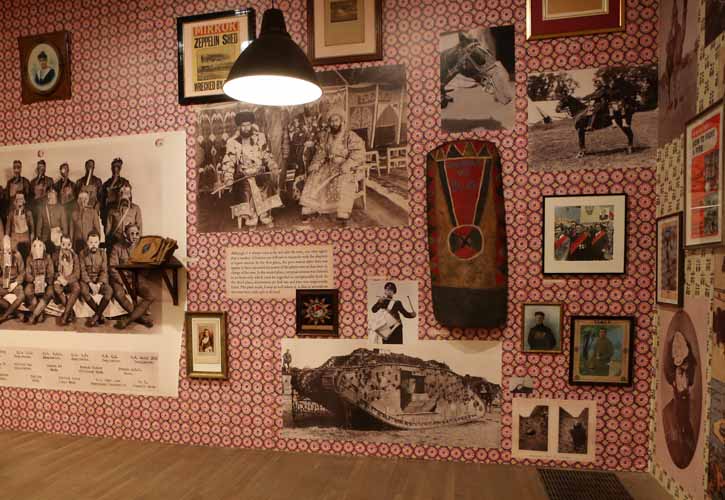Stuart Forster reviews the Conflict, Time, Photography exhibition at the Tate Modern in London, England.
The Tate Modern’s Conflict, Time, Photography exhibition (which ran until 15 March 2015) brought together photographs from conflicts, wars and episodes of armed upheaval around the world and was timed to coincide with a number of other events commemorating the centenary of World War One.
The exhibition featured iconic works such as Don McCullin’s Shell Shocked US Marine, photographed in Hue, Vietnam during 1968, and Toshio Fukada’s The Mushroom Cloud – Less than 20 minutes after the explosion, showing the ominous plume of smoke above Hiroshima, Japan on 6 August 1945.
An emphasis on time
A key aspect of how this exhibition was curated was its emphasis on time. This raised awareness that the passage time can impact how a conflict is regarded and how photographers view their subjects. Innovatively, the works shown were organised according to the period of time since the conflict occurred rather than by theatres of war. This means photos taken a quarter of a century after the fall of Saigon, in Vietnam, and the revolution in Nicaragua were exhibited in close proximity.
I enjoyed seeing reinterpretations of Susan Meiselas’s photo of the ‘Molotov Man’ Pablo Arauz, hurling a Molotov cocktail in Nicaragua during June 1978. The work has been incorporated into graffiti, adverts and posters. It has become an icon.
Viewers were invited to reflect on war’s impact on people and places. The immediate effect of battle can be read in the hollow look on the face of the American marine, photographed by McCullin, gripping the barrel of his M16 rifle. The photo appeared in the first room of the exhibition, themed ‘Moments Later’. The chronological distance from a conflict grows with each gallery. By the eleventh and final room, the photographs examined aspects of wars that took place between 80 and 100 years ago.
The legacy of World War Two
The exhibition illustrated how World War Two left legacies in geographically diverse locations. In Wales, during 1993, Nick Waplington photographed cell walls from a prisoner of war camp. In Poland, Jerzy Lewczynski documented scenes from the Wolf’s Lair (Adolf Hitler’s headquarters) in 1960. In Japan Shomei Tomatsu photographed items found in Nagasaki in 1963.
It’s the ideas behind Tomatsu’s photographs that prove so powerful. A close-up of a damaged watch, stopped at the time the atomic bomb detonated, implies much about the weapon’s impact on its wearer and the power of a precise moment of history, 11:02 on 9 August 1945. A print of his photo showing a steel helmet lying on a cracked, concrete floor would be unremarkable if it were not for the fact a skull bone is fused into the supposedly protective headgear that proved ineffective against the infamous weapon with a plutonium core nicknamed Fat Man.
19th-century war photography
A number of the photos on display dated from the 19th century. George N Bernard’s photographs of William T Sherman’s brutal campaign of destruction in the Confederate States of America, published in 1866, depict the effects of an early form of total war. Did the march through Georgia unite a nation or leave a cleft that was still being felt in the USA a century later?
Roger Fenton’s recorded images of ‘The Valley of the Shadow of Death’ at Balaclava in the Crimea. In 1854 the Light Brigade’s charge did not achieve a decisive military victory but they did ride into the national consciousness via the words of Alfred, Lord Tennyson. Two prints are displayed. One shows cannonballs on the road, the other does not. This raises the question of whether the ordnance was cleared or placed for effect and, thus, what constitutes manipulation of a scene of war.
The scale of modern warfare
Sophie Ristelhueber’s series Fait – photographed in the Kuwaiti desert in 1992, months after the end of fighting – shows the scars of the Gulf War on the barren landscape. The series includes aerial photographs and depicts damaged and abandoned vehicles. The sheer scale of the destruction impresses the effects of modern warfare.
This was a powerful exhibition, one that had me reflecting on what I’d seen and how wars affect people and places long after I’d left the Tate Modern.
At times I thought that the lighting within the rooms could have been a touch brighter; that would have made it easier for me to make out details in a number of the photographs. Also, some of the photos in Kikuji Kawada’s 90-photograph installation The Map were difficult to appreciate fully, due to the height at which they were displayed. Otherwise, though, this was an engaging exhibition.
Conflict, Time, Photography went on tour in Germany during the spring and summer of 2015, at the Museum Folkwang in Essen and then the Staatliche Kunstsammlungen Dresden.
Further information
The Conflict, Time, Photography exhibition was held in the Eyal Ofer Galleries on the third floor of the Tate Modern (Bankside, London, SE1 9TG; tel: +44 (0) 20 7887 8888).
If you enjoyed this post why not sign up for the free Go Eat Do newsletter? It’s a hassle-free way of getting links to posts on a monthly basis.
‘Like’ the Go Eat Do Facebook page to see more photos and content.



